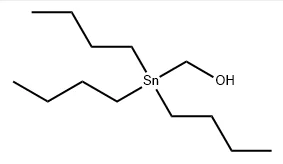(Tributylstannyl)methanol (CAS No.: 27490-33-1), is an organometallic compound widely used in organic synthesis and materials science. Its yellowish oily appearance and unique chemical properties make it a versatile reagent for advanced chemical processes. In this blog post, SACH will share the physical and chemical properties of (Tributylstannyl)methanol for organic synthesis and polymers, its applications, synthesis methods, etc.
Physical and Chemical Properties of (Tributylstannyl)methanol
(Tributylstannyl)methanol exhibits a yellowish oily liquid appearance, with a molecular formula of C13H30OSn and a molecular weight of 321.09 g/mol. It typically meets a purity standard of ≥99%, and is commercially available in units of kilograms, commonly packaged as 25 kg drums.
This compound has a boiling point of 110 °C at 0.01 Torr, indicating its volatility under reduced pressure. It is soluble in organic solvents such as chloroform and dichloromethane, making it highly compatible with common organic reaction systems. The predicted acidity coefficient is 15.10 ± 0.10, reflecting its moderately weak acidic character, which can be relevant in specific organometallic reactions.

Applications of (Tributylstannyl)methanol in Organic Synthesis
One of the primary uses of (Tributylstannyl)methanol (CAS No.: 27490-33-1) is as an organometallic reagent in cross-coupling reactions catalyzed by palladium. These reactions are central to modern organic synthesis and enable the construction of complex molecular frameworks with high efficiency.
A notable application is in the preparation of new carbapenem antibiotics. By serving as a tin-based intermediate, (Tributylstannyl)methanol facilitates selective bond formation in heterocyclic compounds, which are crucial in pharmaceutical development. This role underscores its importance in medicinal chemistry, particularly in the synthesis of molecules with high biological activity.
Role in Materials Science: Organotin Polymers
Beyond pharmaceuticals, (Tributylstannyl)methanol (CAS No.: 27490-33-1) has significant utility in materials science, especially in polymer synthesis. It can act as an initiator or modifier for the creation of organotin polymers with specialized properties, such as improved thermal stability, mechanical strength, or chemical resistance.
Its organometallic nature allows it to integrate seamlessly into polymer backbones, modifying polymer behavior at the molecular level. Researchers utilize this capability to design advanced functional materials for applications ranging from coatings and adhesives to biomedical polymers.
Synthesis Methods of (Tributylstannyl)methanol
Method 1: Dichloromethane-Mediated Reaction
A common laboratory synthesis involves reacting tributyltin chloride with iodomethane in dichloromethane under nitrogen protection. The process is carried out in a 250 mL round-bottom flask over 8 hours. After reaction completion, the solution is washed sequentially with distilled water, saturated sodium bicarbonate, and saturated sodium chloride, then dried over anhydrous sodium sulfate.
The resulting organic solution is filtered and evaporated under reduced pressure to obtain a crude product, which is a colorless transparent liquid. This method ensures high purity and efficient yield for further chemical applications.
Method 2: One-Step Reaction
Alternatively, (Tributylstannyl)methanol can be prepared in a one-step reaction between tri-n-butyl hydrogen tin and paraformaldehyde. This simplified method reduces handling steps and is suitable for scale-up production, though reaction conditions must be carefully controlled to maintain product integrity.
Storage Conditions for (Tributylstannyl)methanol
Due to its sensitivity to light, heat, and moisture, proper storage is crucial for maintaining the stability of (Tributylstannyl)methanol. It should be sealed and stored in a cool, dry, and dark environment, ideally in brown glass bottles or black-wrapped containers.
It should be kept away from fire and heat sources, as elevated temperatures may accelerate decomposition or volatilization. Adhering to these conditions ensures that the compound retains its chemical activity and minimizes the risk of accidental hazards.
Safety and Handling Precautions
(Tributylstannyl)methanol possesses moderate toxicity and can be irritating to the skin, eyes, and respiratory tract. Appropriate protective measures must be taken during handling, including the use of gloves, safety goggles, and masks.
Additionally, the compound is harmful to aquatic life, and care must be taken to prevent environmental contamination. Spillage or disposal should follow strict chemical safety protocols to minimize ecological impact.
Regulatory Considerations
Given its toxicity and environmental impact, (Tributylstannyl)methanol is subject to chemical safety regulations. Laboratories and manufacturing facilities must comply with local and international guidelines regarding storage, handling, and disposal. This ensures both personnel safety and environmental protection.
Conclusion
(Tributylstannyl)methanol (CAS No.: 27490-33-1) is a versatile organometallic compound with broad applications in organic synthesis and polymer science. Its ability to participate in palladium-catalyzed cross-coupling reactions makes it indispensable in pharmaceutical research, especially for carbapenem antibiotic development. Simultaneously, its role in creating specialty organotin polymers highlights its value in materials innovation.
www.hzsqchem.com
SACH